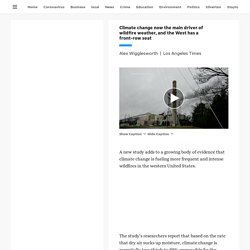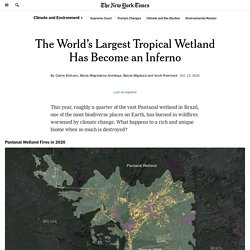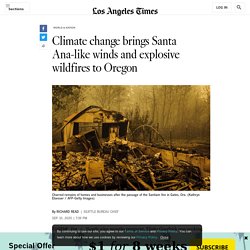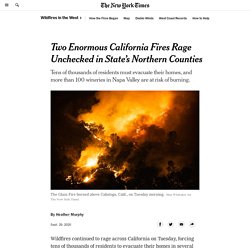

New images show wildlife thriving in Opal Creek after 2020 wildfires. Flames from the 2020 Labor Day Fires decimated and closed the popular Opal Creek Recreation Area.

Since then, few members of the public have been within the closure zone. However, one man, Ralph Bloemers, has set out to show how the forest there is healing using wildlife cameras. Earlier this year, Bloemers received permission from the Forest Service and Opal Creek Ancient Forest Center staff to place his cameras within the closure zone. In June, he placed more than a dozen cameras across the recreation area. "There's just a lot of misunderstanding about what fire does to forests, and I felt that the best way to address those was just to show people the thing itself," Bloemers said. When Bloemers went to check the cameras in November, he found they had captured images of a variety of animals and the wildlife seemed to be doing well.
The pictures and videos showed deer and elk eating new growth. The animals weren't the only thing he noticed in the images. Climate change now the main driver behind wildfire weather: study. Alex Wigglesworth | Los Angeles Times A new study adds to a growing body of evidence that climate change is fueling more frequent and intense wildfires in the western United States.

The study’s researchers report that based on the rate that dry air sucks up moisture, climate change is essentially two-thirds to 88% responsible for the conditions driving the region’s wildfire woes. And that’s a conservative estimate, said study author Rong Fu, a climate researcher at UCLA. “It’s happened so much faster than we previously anticipated,” she added. The study, published this week in the Proceedings of the National Academy of Sciences, looks at what’s known as the vapor pressure deficit, which basically describes how thirsty the atmosphere is, Fu said. The researchers found this to be the leading meteorological variable that controls how much land burns in the western U.S. during a given fire season. Forest Service plans sweeping tree removal in wildfire-impacted areas.
58 Photos.

What we know about the causes of the Oregon Labor Day Fires. Santiam Canyon, Detroit recreation likely limited after wildfires. 58 Photos.

Oregon wildfires leave historic impact, months later recovery begins. Replanting well underway in burned areas of Santiam State Forest. Oregon timber owners work feverishly to salvage burned wood. They’re Among the World’s Oldest Living Things. The Climate Crisis Is Killing Them. Sequoia Crest, Calif. — Until a few years ago, about the only thing that killed an old-growth giant sequoia was old age.

Not only are they the biggest of the world’s trees, by volume — the General Sherman Tree, considered the largest, is 36 feet in diameter at its base and 275 feet tall — they are among the oldest. At least one fallen giant sequoia was estimated to have been more than 3,200 years old. They last so long that, historically, only one or two of every thousand old-growth trees dies annually, according to Nate Stephenson, a research ecologist for the United States Geological Survey. Fire always was a frequent visitor to sequoia groves, but rarely a threat. Mature sequoias are virtually fireproof because the bark can be several feet thick. Until now. Dr. Wildfire in Santa Cruz mountains. With cool, humid weather and stable winds providing optimal firefighting conditions, crews continued to harness flames and build containment lines overnight around the destructive blaze that has swallowed homes and leveled vast swaths of forest in the Santa Cruz Mountains.

The CZU August Lightning Complex grew less than 200 acres overnight and was 78,869 acres as of Tuesday morning, Cal Fire officials said at a Tuesday morning press briefing. This is a dramatic decrease in the rate of the fire's growth. Last week, there were nights when the blaze grew at a rate of up to 1,000 acres an hour. The blaze went from 13% containment Monday morning to 17% containment this morning. The count of homes destroyed has gone up to 330 with 11 of those in San Mateo County and 319 in Santa Cruz County. "The past couple days we've seen significant progress in our firefight on this incident," said Cal Fire Operations Chief Mark Brunton. Nearly Half of the U.S. Is in Drought. It May Get Worse. Nearly half of the continental United States is gripped by drought, government forecasters said Thursday, and conditions are expected to worsen this winter across much of the Southwest and South.

Mike Halpert, deputy director of the Climate Prediction Center, a part of the National Oceanic and Atmospheric Administration, said a lack of late-summer rain in the Southwest had expanded “extreme and exceptional” dry conditions from West Texas into Colorado and Utah, “with significant drought also prevailing westward through Nevada, Northern California and the Pacific Northwest.” Much of the Western half of the country is now experiencing drought conditions and parts of the Ohio Valley and the Northeast are as well, Mr. Halpert said during a teleconference announcing NOAA’s weather outlook for this winter. This is the most widespread drought in the continental United States since 2013, he said, covering more than 45 percent of the Lower 48 states. The World’s Largest Tropical Wetland Has Become an Inferno. This year, roughly a quarter of the vast Pantanal wetland in Brazil, one of the most biodiverse places on Earth, has burned in wildfires worsened by climate change.

What happens to a rich and unique biome when so much is destroyed? Climate change brings Santa Ana-like winds, fires to Oregon. Nearly nine months pregnant, Elisha Goodrick was cooking chicken piccata Monday evening when she noticed something eerie — weather like she had never experienced in western Oregon.

It was strange enough to see ash falling like snow outside her kitchen window as a wildfire galloped through mountainsides somewhere above. But what alarmed her was the pounding on the roof as an extraordinary wind raged in the tops of Douglas firs, raining branches on the blue-shingled house. It wasn’t long before a volunteer-firefighter friend called. Two Enormous California Fires Rage Unchecked in State’s Northern Counties. Wildfires continued to rage across California on Tuesday, forcing tens of thousands of residents to evacuate their homes in several counties and threatening restaurants and wineries in the state’s northern wine country.

As two massive blazes consumed large expanses of the state throughout the morning, California was rapidly advancing toward a record four million acres burned in a single year. The Glass Fire, which began as three separate fires on Sunday that merged, continued expanding across Napa County on Tuesday. Oregon wildfire smoke brings record-breaking poor air quality, DEQ says. PORTLAND, Ore. — According to a recent report from the Oregon Department of Environmental Quality, Oregon has seen record poor air quality in cities across the state.
RELATED| Portland's air quality is really bad, but it's not the worst in the state DEQ and Lane Regional Air Protection Agency compared recent and historical Air Quality Index information for Portland, Eugene, Bend, Medford and Klamath Falls. They found that all five cities exceeded previous daily records for poor air quality during wildfire season, according to the DEQ. All previous records were set in September 2017. Other than Medford, no city has previously experienced a hazardous air quality day since DEQ began monitoring, officials said. How an Oregon Wildfire Became One of the Most Destructive. Wildfires May Pose Drinking Water Safety Issues. Two months after a wildfire burned through Paradise, Calif., in 2018, Kevin Phillips, then a manager for town’s irrigation district, walked from one destroyed home to another.
Burned out cars, the occasional chimney and the melted skeletons of washers and dryers were the only recognizable shapes. “You started to actually be shocked when you saw a standing structure,” he said. Mr. Record Wildfires on the West Coast Are Capping a Disastrous Decade. With more than a month of fire weather ahead for large parts of the West Coast, the 2020 fire season has already taken a disastrous toll. Combined, over five million acres have burned in California, Oregon and Washington so far.
Thousands of buildings have been destroyed by some of the largest fires ever recorded. More than two dozen people have died. Millions up and down the coast have spent weeks living under thick clouds of smoke and ash. “We’ve broken almost every record there is to break,” said Daniel Swain, a climate scientist at the University of California, Los Angeles, referring to his home state, where catastrophic fires have become an almost-yearly occurrence. Data from two NASA satellites that can detect heat shows fire activity in California, Oregon and Washington in 2020 has already eclipsed even the worst previous year. 2020 is the most active fire year on record for the West Coast.
Wildfires in West have gotten bigger, more frequent and longer since the 1980s. Dramatic images of out-of-control wildfires in western North American forests have appeared on our television and computer screens with increasing regularity in recent decades, while costs of fire suppression have soared. In 2015, federal spending on suppression exceeded US$2 billion, just 15 years after first exceeding $1 billion. In Oregon, a New Climate Menace: Fires Raging Where They Don’t Usually Burn.
Megan twohey From The New York Times, I’m Megan Twohey. This is “The Daily.” Today: As wildfires continue to rip through parts of the West, Oregon is seeing unprecedented destruction. My colleague Jack Healy talks to those living in its path. [music] Wildfires Are Worsening. The Way We Manage Them Isn’t Keeping Pace.